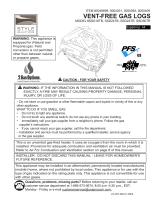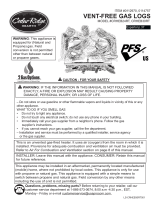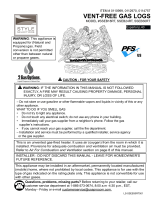Page is loading ...

ESSE Engineering Limited, Long Ing, Barnoldswick, Lancashire BB18 6BN
Tel: 01282 813235 Fax: 01282 816876
10/07
firewall
FLUELESS CAT GAS FIRED HEATERS
Models: 41” & 48” Widescreen
USER INSTRUCTIONS
ESSE Engineering Limited, Long Ing, Barnoldswick, Lancashire BB18 6BN
Tel: 01282 813235 Fax: 01282 816876 Website: http://www.esse.com
GB IE

1. GENERAL
2. IMPORTANT NOTES
This heater has been individually designed to add charm and character to your home and provides a
highly efficient heat source, coupled with the convenience of clean burning gas. Due to newness of
materials the heater may give off a slight smell for a period of time after commissioning. This is quite
normal and any odours should disperse after a few hours operation. An electrical appliance such as a
television should not be fitted above the appliance. It is recommended that the heater is used only as a
secondary heat source. It has been supplied for use on Natural Gas or LPG. The data plate is situated on
the backplate (Fig1).
The installation must be in accordance with National Regulations and must be carried out by a qualified
person. Under no circumstances should the appliance be operated without the glass inner frame
attached or the glass damaged. All surfaces except the controls are considered to be working surfaces.
Most parts of the heater will get hot during and after use. If young children, the elderly, or infirm are likely
to be near the heater a suitable fireguard, conforming to BS8423, is recommended. Do not place any
objects on top of the heater. In particular never cover or partially cover the grille. The integral catalyst
should be checked by the installer upon servicing to ensure that there are no defects or obstructions. The
expected life of the catalyst is in excess of 11,000 hours (10 years of normal use). After this time the
catalyst should be replaced. Due to the high temperature reached within the heater, surface cracks may
appear on the backboard behind the flames, this is quite normal and will not affect the safe operation of
the heater. The room that the heater is installed in must not be used as a bedroom or sleeping area.
Fig.1. Manual version of Widescreen Firewall Remote version of Widescreen Firewall
DATA PLATE
ON BACK PLATE
DATA PLATE
ON BACK PLATE
VALVE
CONTROL
VALVE
CONTROL
Warning: There are always dust particles in the air in every living space, even if it is regularly vacuumed!
These particles are visible in rays of sunlight and they will not bother you as long as the concentration of
particles in the air remain low. The indoor climate can only be described as bad if these particles are floating
through the room in large qualities for any reason whatsoever and if the air is additionally polluted by soot
and tar particles caused by the burning if oil lamps for example, and by smoking cigarettes and cigars. In
a heated living space, cooled air slowly streams across the floor to the combustion appliance. The air is
heated in the convection system of the heater, causing a fast rising column of warm air to develop, which
then spreads throughout the room again. As a consequence, this air always contains dust and other
pollutant particles that may leave deposits on cold and often damp surfaces. This is potentially a particular
problem in new buildings that are not yet dry (construction moisture). An unwelcome result of this
phenomenon could be discolouration of walls and /or ceilings. Wait at least 6 weeks before firing a newly
bricked room or after renovations, since the construction moisture must have disappeared completely from
the walls, floor and ceiling. The room where the appliance is located must be well ventilated and the
required ventilation must be in compliance with the Installation Instruction. Do not use candles or oil lamps.
These provide considerable quantities of pollutant and unhealthy soot particles in your home. Smoke from
cigarette and cigars contain tarry substances, which may also leave deposits on colder and damp walls
when heated. If the interior climate is bad, this phenomenon may also occur above radiators and lighting
fixtures and at ventilation grilles, although to a lesser degree.
If decorating around the heater ensure that adequate precautions are taken to prevent paint etc from
coming into contact with the heater. Do not use masking tape on the front panel.
3. CLEARANCES
To electrical devices - Under no circumstances must any electrical device (e.g Plasma T.V.) be walll
mounted above a firewall.
To combustibles - Minimum clearance to the sides of the heater are 100 mm (4in) but curtains, drapes and
other fabrics are not permitted within a distance of 500 mm (20 in) of the stove sides. No such materials are
permitted directly above the heater regardless of distance. Clearances to the front of the heater is 1000 mm
(39 in). A combustible shelf may be fixed to the wall above the heater, providing that it complies with the
dimensions given below and is rated at a minimum of 100°C otherwise discolouration or smells may
occur. If in doubt refer to the shelf manufacturer.
The shelf depth may be increased up to a maximum of 457mm (18") but the height must also be increased
accordingly. An increase in height of 25 mm is required for every 12.5 mm of additional shelf depth. For
shelves that are too low, protective devices can be used such as metal heat deflectors, but it must be
assured that the shelf does not reach an unacceptable temperature before relying on such a solution.
As with all heating appliances, any decorations,
soft furnishings, and all coverings (i.e. flock,
blown vinyl and embossed paper) positioned
too close to the appliance may discolour or
scorch.
2 3
Maximum depth of shelf Minimum distance from top
of outlet grille to underside
of shelf
75mm (3in) 305mm (12in)
150mm (6in) 457mm (18in)
457mm (18in) 1067mm (42in)

4. VENTILATION
Purpose provided ventilation of 100cm2 is required for this heater. This ventilation must never be blocked
or partially blocked. An openable window or equivalent is also required. Ventilation fitted under, or within
immediate vicinity of the heater must not be used as it may adversely effect performance of the combustion
monitoring system (ODS) system.
The requirements of other appliances operating in the space or room must be taken into consideration
when assessing ventilation requirements, this will have been carried out by your CORGI registered installer.
A supply of fresh air into the room is advisable to maintain temperatures within limits. The heater MUST
NOT be installed in a bedroom, bathroom or any sleeping area. Additionally for L.P.G. – the heater must
not be used in cellars or basements.
5. BURNER ARRANGEMENT
The burner should only be used with vermiculite granules as shown in the Installation Instructions. The
heater must only be fitted with the vermiculite supplied. DO NOT add any extra logs or coals.
6. OPERATING THE HEATER
Fig.2. Sideview of valve Fig 3. Manual version - control knob
PILOT
OFF
CONTROL
KNOB
A) MANUAL VERSION
(a) Lighting the Pilot (Fig.3)
Depress control knob fully. Whilst depressed turn knob slowly anti-clockwise to ‘PILOT’ setting.
A click will be heard and the spark should light the pilot. Repeat until pilot is visibly lit. The operation of the
spark can be viewed on the pilot assembly at the right hand end of the burner.
Keep knob depressed at this point for 10 - 15 seconds and release the knob. Preferably the pilot should
be left to stabilise for approximately 5 minutes before igniting the burner.
(b) High Setting (Fig.3)
Ensure that the pilot is lit as described above.
With control knob at ‘PILOT’ setting, depress and turn anti-clockwise to ‘HIGH’ setting and release
the knob. After a few seconds the burner will light on high setting.
(c) Low Setting (Fig.3)
With the heater lit on ‘HIGH’ setting, as described above, output can be decreased by turning the control
knob progressively in a clockwise direction until the desired level is achieved, down to the ‘LOW’ setting.
(d) Turning the Heater OFF (Fig.3)
From any heat setting, depress the control knob fully and turn clockwise to ‘PILOT’ position.
(e) Turning the Pilot OFF (Fig.3)
From any heat setting or the ‘PILOT’ position, depress the control knob fully and turn clockwise to ‘OFF’ position.
(B) REMOTE CONTROLLED VERSION
The heater has a pilot that must be lit manually. When lighting the pilot follow these instructions exactly.
Lighting the Pilot
Push in gas control knob slightly and turn clockwise to ‘OFF’ (knob A).
Turn knob A counter clockwise towards the ignition
position (IGN) until reaching stop, press down and
hold for five seconds (only pilot gas flows).
Continue pressing down knob A while turning
further counter clockwise to activate piezo,
continue to hold down for ten seconds after pilot
burner has been lit. If pilot does not light, steps 1
and 2 can be repeated immediately. Upon lighting,
release knob and turn further counter clockwise to
ON position. Pilot gas and main gas flow are now
in accordance to the setting of Knob B (see remote
transmitter operation on p6).
Fig. 6 - Remote control version - control knobs
Note: Knob A cannot be turned from ‘PILOT’ to
‘OFF’ unless knob is pushed in slightly. Do not force.
The heater is fitted with a pilot light which is also an oxygen depletion sensor (ODS), piezo spark and
flame sensing device. The control is located behind the front panel on the lower right hand side (Fig 2).
The pilot light is located centrally behind the burner.
Should the heater be extinguished for any reason wait 3 minutes before re-ignition is attempted. The
heater should not be used at a lower setting than the ‘LOW’ position.
Important: It is recommended that the pilot light be left ‘on’ even if the main burner is turned ‘off’.
4 5
KNOB B
KNOB A

7. COMBUSTION MONITORING SYSTEM
This heater is fitted with a combustion monitoring safety device (ODS). If the heater shuts off during use
for no apparent reason then several reasons may be suspected. If a door or window has been opened
creating a draught, then pilot disturbance could be the problem and removal of the draught should resolve
this. The heater can then be re-lit in accordance with the previous section.
If pilot disturbance is not the cause, then the ODS safety system may be in operation. Switch the heater
OFF; call in your installer to check the heater and ventilation. Remedial work must be carried out as
required. DO NOT allow the heater to be used until the heater and installation is passed as safe. If the
pilot continues to be extinguished, you must call your installer to check the operation of the complete
heater.
8. CLEANING
Ensure that the heater is turned off before cleaning and is cold. DO NOT use abrasive cleaning agents.
Glass panels can be cleaned with a suitable glass cleaner. Test on a small area first.
9. SERVICING
It is essential that the heater is regularly serviced at least annually.
BUTTON A
To turn off the gas to the heater for prolonged periods
Turn knob A clockwise until reaching stop. In this position only pilot gas flows. To shut if the valve
completely, press down slightly and continue to turn clockwise from pilot position to the OFF position. The
safety interlock prevents re-ignition of the pilot flame until the thermocouple has cooled down sufficiently
(elapsing time will vary based on thermocouple type). Switching off the remote is not necessary.
FLAME HEIGHT ADJUSTMENT
l Simultaneously press both the (
s) button and the small button (A) to turn on the main burner or increase
the flame height.
l For incremental increases in flame height, the small button must be continuously depressed while
intermittently depressing the (
s) button.
l To decrease the flame height or shut off the main burner, simply depress only the (
t) button.
CHANGING BATTERIES
If the batteries in the transmitter or receiver lose power, the flame height can be adjusted by manually turning
knob B until new batteries are fitted.
Fig. 5 - Remote Transmitter G30-ZRHSO
Note: Mains electrical power is not required as
this system runs on batteries only (alkaline
recommended). Battery information: Handset –
1 x 9V block, Receiver – 4 x 1.5V AA.
Note: It is recommended to turn the combination
control either to the off or pilot position if the
appliance is left unattended for long periods
(e.g. away on holiday), so that it cannot receive
commands from the remote transmitter.
Exercise caution when leaving the appliance
unattended, in exceptional cases sound waves
from sources other that the transmitter can
cause flame height adjustment. For the handset
to function correctly, the transmitter must
remain within range of the receiver. The
transmitter should not be used in very close
proximity to the receiver (less than 1m/3ft) as
this could, in very rare cases, produce an
electronic switching error. This error could block
the motor when the knob reaches the end
points of its turning radius. The knob must then
be turned manually to free the blockage.
6 7
/



